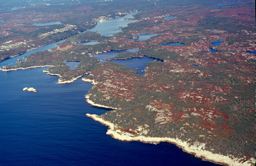 Terence Bay Wilderness Area is a rugged, 4,551 hectare (ha) coastal and near-coastal wilderness within the suburban fringe of Halifax Regional Municipality. It is part of an 8,000 ha assemblage of coastal parks and protected areas between Peggy’s Cove and Sambro, in western Halifax Regional Municipality.
Terence Bay Wilderness Area is a rugged, 4,551 hectare (ha) coastal and near-coastal wilderness within the suburban fringe of Halifax Regional Municipality. It is part of an 8,000 ha assemblage of coastal parks and protected areas between Peggy’s Cove and Sambro, in western Halifax Regional Municipality.
Together with the adjacent Long Lake Provincial Park, Terence Bay Wilderness Area forms a nearly 20 km natural corridor between Spryfield (Halifax) and the Atlantic Ocean.
Much of Terence Bay Wilderness Area is typical of Nova Scotia's Pennant Coastal Barrens Natural Landscape, which extends from Peggy's Cove to York Redoubt in Halifax Harbour. This includes dramatic granite headlands, rugged barrens and patches of coastal, conifer forest. This rugged terrain extends inland, but is here consistently forested with mixtures of spruce, fir, maple, birch and some white pine. Lakes and streams are common throughout. The climate is tempered by the Atlantic Ocean, which moderates temperatures and can create windy and foggy conditions.
Protection of these landscape features helps improve representation of the Pennant Coastal Granite Barrens Natural Landscape in Nova Scotia’s protected areas system.
The wilderness area offers excellent opportunities for wilderness recreation in a near-urban setting. The coastal portion can be experienced by kayaking and other small craft, with opportunities to extend this to other protected areas towards both Peggy’s Cove and Sambro. Portions of the coast and elsewhere can be hiked, though managed trails do not exist. Several portages connect Quarry Lake and Whale Cove Lake to separate parts of the coast, enabling a loop trip by canoe that combines marine and freshwater paddling. Angling, hunting and other recreational pursuits occur throughout.
A few private parcels were acquired by the Province and added to the wilderness area in 2004, 2015 and 2020 to improve boundaries and management.

